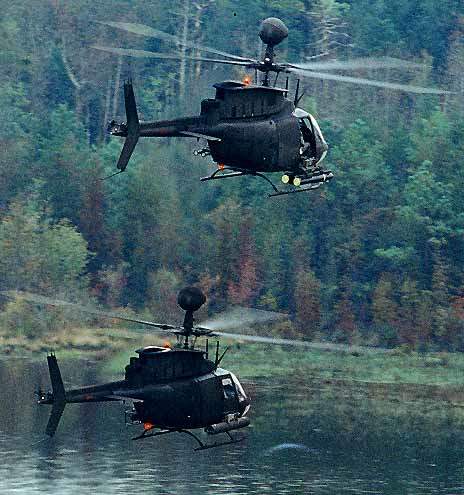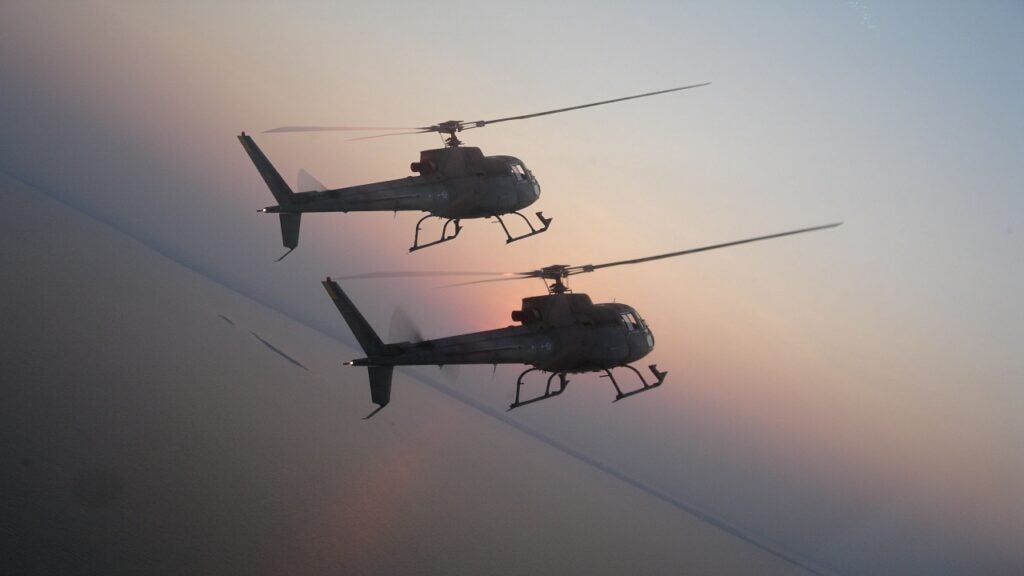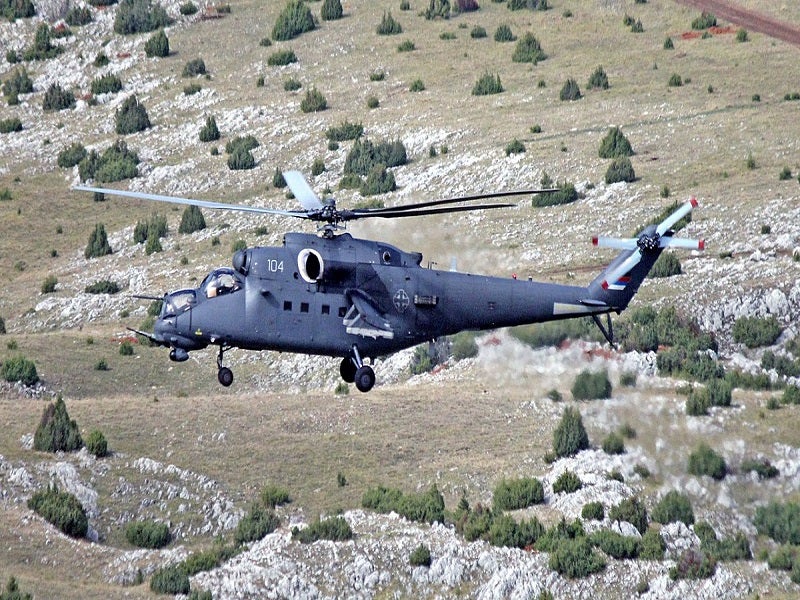
The Armed OH-58D Kiowa Warrior, in service with the US Army, is supplied by Bell Helicopter Textron of Fort Worth, Texas. Around 375 Kiowas are in service and the single engine, double-bladed armed reconnaissance helicopter has been deployed in support of United States armed forces around the world including Haiti, Somalia and the Gulf of Arabia (Desert Storm and Desert Shield).
In 2002, Kiowas were deployed as part of Nato’s SFOR forces in Bosnia and, in 2003, 120 Kiowas were deployed in support of Operation Iraqi Freedom. 29 helicopters were lost during that operation. The US Army Kiowa fleet achieved a total of 750,000 combat hours until the end of 2011.
Kiowa helicopter missions and roles
The primary mission of the helicopter is in the scout attack role. The helicopter can be optionally equipped to carry out transport and utility roles using equipment kits installed externally on existing hard points.
A cargo carrying hook is rated to carry loads up to 2,000lb. Emergency casualty evacuation can be carried out transporting two casualties on litters (stretchers), plus over 320kg of supplies to an operating radius of more than 185km. The Kiowa can be used for insertion of up to six troops for critical point security missions.
Two Kiowas can be transported in a C-130 aircraft. For air transportation the vertical tail fin pivots, the main rotor blades and the horizontal stabiliser are folded, and the mast mounted sight, the IFF antenna and the lower wire cutter are removed. The landing gear can kneel to decrease the height.
The OH-58D Kiowa Warrior was to be replaced by the next-generation armed reconnaissance helicopter (ARH) within the US Army. A contract worth $211m for the ARH, a military version of the Bell 407, was awarded to Bell Helicopter in July 2005. Under the contract, Bell was required to supply 368 helicopters between 2008 and 2013.
In order to replace four Army National Guard attack helicopter battalions, the number of helicopters to be delivered was increased from 368 to 512. In July 2008, the US Army discovered that the ARH programme had exceeded cost-growth limits of the Nunn-McCurdy Act. The ARH programme was therefore terminated in October 2008.
Kiowa Safety Enhancement Programme (SEP)
To maintain the safety and effectiveness of the Kiowa fleet until retirement, a safety enhancement programme (SEP) was launched as a part of the Army Scout refreshment programme in 1998. The SEP provided engine upgrades and improved computer control systems for 292 Kiowa helicopters. The programme was concluded in September 2011.
In March 2009, the US Army awarded a contract to Bell Helicopter to upgrade an additional 27 OH-58D aircraft under the Kiowa Warrior SEP.
Upgrade work on the 27 aircraft began in April 2009 and deliveries began in the last quarter of 2009 at a rate of three aircraft a month. In March 2010 the US Army awarded a contract to modify the final 30 OH-58D aircraft under the SEP. Work on the final lot of aircraft in the SEP was started in March 2010 and completed in 2011. The upgrade was carried out at Bell Helicopter’s plant 1 facility in Fort Worth, Texas.
In October 2010, the US Army provided the “Fox” designation to the upgraded version of OH-58D Kiowa Warriors. The new version is known is OH-58F or Fox and will have an upgraded cockpit and sensor. The upgraded fleet is expected to be deployed in the fourth quarter of 2015.
OH-58D cockpit
The Kiowa was the first US Army helicopter to have an all-glass cockpit. The cockpit is supplied by Sperry Flight Systems and is equipped with a multiple target tracking / moving target indicator, an ANVIS (aviation night-vision system) display symbology system and helmet-mounted display.
The primary multifunction displays provide situation information, communications control and the mast-mounted sight video. A video recorder stores television and thermal imagery from the mission and allows playback in the cockpit.
Kiowa weapons
The OH-58D is equipped with two universal quick-change weapons pylons. Each pylon can be armed with two Hellfire missiles, seven Hydra 70 rockets, two air-to-air Stinger missiles or one .50-calibre fixed forward machine gun.
Lockheed Martin successfully test-fired its DAGR guided rockets from OH-58D Kiowa Warrior helicopter in March 2010.
Mission processors control the suite of mission subsystems via a military standard 1553B bus. An onboard computer provides laser ranging and target location within 10m.
Countermeasures
The countermeasures suite includes an AN/ALQ-144 infrared jammer, radar warning receivers against pulsed and continuous wave radars and a laser warning detector.
Fire control and observation
The distinctive mast-mounted sight (MMS) from Boeing, situated above the rotor blades, enables the Kiowa Warrior to operate by day and night and to engage the enemy at the maximum range of the weapon systems and with the minimum exposure of the helicopter.
The MMS contains a suite of sensors which includes: a high-resolution television camera for long-range target detection; a thermal imaging sensor for navigation, target acquisition and designation; a laser rangefinder / designator for target location and guidance of the Hellfire missiles and designation for Copperhead artillery rounds; and a boresight assembly which provides in-flight sensor alignment. The laser rangefinder / designator is also employed for handoff to an AH-1 Cobra helicopter for TOW missile engagements.
The MMS is principally used for collecting imagery and target acquisition data of the battlefield during the day or night, under extreme adverse conditions.
DRS Technologies is currently responsible for the sensor suite and, in March 2004, was awarded an $8.2m contract to upgrade the thermal imaging system on the MMS. The thermal imaging system upgrade (TISU) provides enhanced target detection and range. Deliveries began in August 2005 and were completed in early 2006.
The contract is part of a five-year $514m master indefinite delivery / indefinite quantity (IDIQ) contract awarded to DRS in December 2003.
In February 2006, the US Army Aviation and Missile Command (AMCOM) awarded another TISU contract worth $33m. Product deliveries began in February 2006 and were completed in December 2008.
A new five-year contract (January 2009-December 2013) worth $913m was awarded to DRS in February 2009 to support the maintenance, repair and service of the MMS on the OH-58D Kiowa Warrior. This is a follow on of the previous $514m contract.
Under the contract, DRS was awarded a $110m contract to supply spare components, repairs and programme services for the MMS in April 2009. The contract includes delivery of new spare parts from June 2009 to March 2013 with repair and maintenance services scheduled from June 2009 to January 2012.
Navigation and communications
The US Army OH-58D is equipped with an attitude heading reference system (AHRS) from Litton and an integrated Global Positioning System and Inertial Navigation System, GPS/INS.
A data-loading module allows the pre-mission storing of navigation waypoint data and radio frequencies. The mission equipment includes an improved data modem for digital battlefield communications, (IDMDBC). The communications system is based on the Have-Quick UHF and SINCGARS FM anti-jam radio.
Kiowa Warrior engine
The OH-58D helicopter is equipped with a Model 250 485kW turbine engine from Rolls-Royce. The transmission has a transient power level of 475kW. The engine and transmission system have been upgraded to provide high performance levels in high temperature and extreme climates.
The Global Military Rotorcraft Market 2011-2021
This project forms part of our recent analysis and forecasts of the global military rotorcraft market available from our business information platform Strategic Defence Intelligence. For more information click here or contact us: EMEA: +44 20 7936 6783; Americas: +1 415 439 4914; Asia Pacific: +61 2 9947 9709 or via email.




